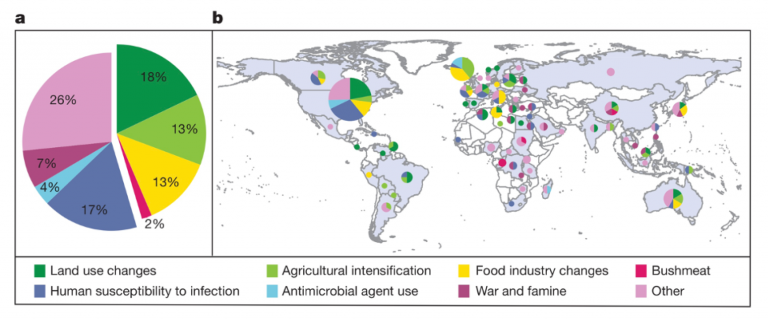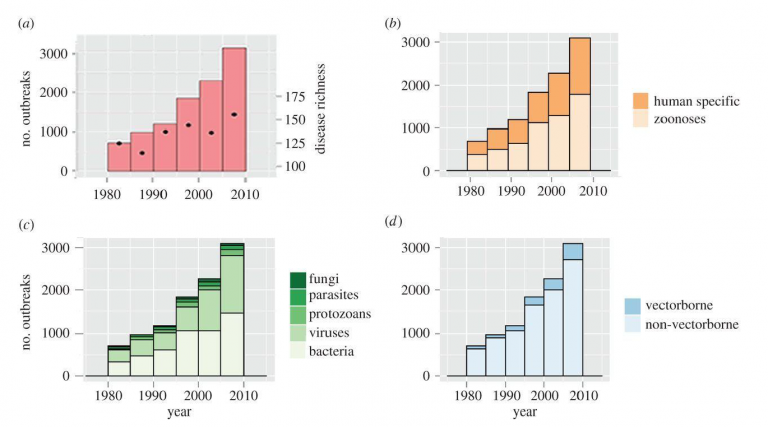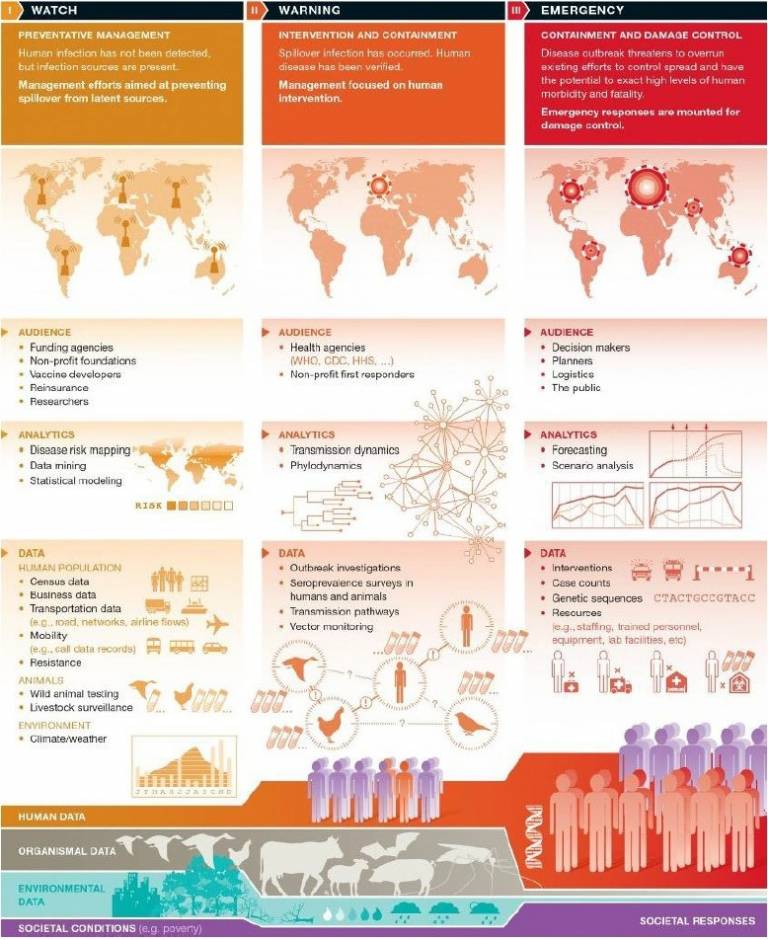Claudia Fernandez de Cordoba Farini and Dr Carina Fearnley (UCL Warning Research Centre, STS) on The Need for Preventative Health Warning Systems that Integrate Environment and Society
Currently, most early warning systems (EWS) for infectious disease are led by human or animal health specialists. While they use different sources and methodologies - drawing information from member state countries (e.g. GOARN) to social media (e.g. Health map, Epitweeter) - they mainly monitor and rely on human or animal health data. Consequently, they can only signal an alert once it has affected the human or animal population and implement responsive strategies to prevent diseases from spreading further. There is a lack of attention towards prevention and the pre-spillover environmental and climatic conditions that increase health risks to begin with such as deforestation, land use change, intensive livestock production, and climate change.

Drivers and locations of emergence events for zoonotic infectious diseases in humans from 1940–2005. a, Worldwide percentage of emergence events caused by each driver; b, Countries in which the emergence events took place, and the drivers of emergence. Globally, almost half of these diseases resulted from changes in land use, changes (Keesing et al., 2010, p651).
A study published in 2008 by Jones et al. estimated that while per-outbreak cases have been falling since the 1980s, the number of new infectious disease outbreaks is increasing notably over time. These findings indicate that while our ability to contain and quickly respond to emerging infectious diseases is improving overall, human activities are also simultaneously increasing the rate of emergence of infectious diseases. Numerous studies have subsequently supported the rise of emerging infectious diseases, even after accounting for reporting bias.

Global number of human infectious disease outbreaks and richness of causal diseases 1980–2010. Outbreak records are plotted with respect to (a) total global outbreaks (left axis, bars) and total number of diseases causing outbreaks in each year (right axis, dots), (b) host type, (c) pathogen taxonomy and (d) transmission mode. (Smith et al., 2014, p2.)
At the centre of the next COP 26 there needs to be a greater emphasis in building bridges between environmental and public health sectors in order to improve EWS capacity to prevent damaging health events such as COVID-19. Organisations such as the European Environment and Epidemiology Network which aim to integrate health, weather, environmental and other types of data in the prevention of infectious diseases lay the foundation for more holistic warning systems. Their success in preventing the continuous re-emergence of certain diseases by mapping risk areas and their common environmental factors (e.g. Malaria, Greece, 2013) indicate a strong potential for creating effective anticipatory strategies and consequently stop the rise of new infectious diseases.
Han and Drake (2016) envisaged what a holistic global EWS for pandemics could look like dividing its components in three categories: preventative management, intervention and containment, containment and damage control. Currently efforts are most focused on the last two parts of the system. To direct efforts towards prevention and identifying and tackling their common drivers, it is crucial we start visualising epidemics/pandemics jointly from an environmental perspective rather than as independent health events.

Future directions in analytics for infectious disease intelligence: Toward an integrated warning system for emerging pathogens (Han and Drake, 2016, p786).
Dobson et al. (2020) estimated that the cost of preventing the next pandemic is only 2% of the cost we are currently paying for COVID-19. Sustainability and environmental health protection are too often understood as an expense blocking economic growth. It is time we change that conception and start visualising and understanding them as critical and profoundly beneficial long term investments.
References:
Dobson, A. P., Pimm, S. L., Hannah, L., Kaufman, L., Ahumada, J. A., Ando, A. W., ... & Vale, M. M. (2020). Ecology and economics for pandemic prevention. Science, 369(6502), 379-381.
Han, B. A., & Drake, J. M. (2016). Future directions in analytics for infectious disease intelligence: Toward an integrated warning system for emerging pathogens. EMBO reports, 17(6), p785-789.
Jones et al.
Jones, K. E., Daszak, P., Gittleman, J. L., Storeygard, A., Balk, D., Levy, M. A., & Patel, N.G. (2008). Global trends in emerging infectious diseases. Nature (London), 451(7181), 990-993.
Keesing, F., Belden, L., Daszak, P., Dobson, A., Harvell, C., & Holt, R. et al. (2010). Impacts of biodiversity on the emergence and transmission of infectious diseases. Nature, 468(7324), 647-652. doi: 10.1038/nature09575
Smith, K. F., Goldberg, M., Rosenthal, S., Carlson, L., Chen, J., Chen, C., & Ramachandran, S.(2014). Global rise in human infectious disease outbreaks. Journal of the Royal Society Interface, 11(101), 20140950.
 Close
Close

